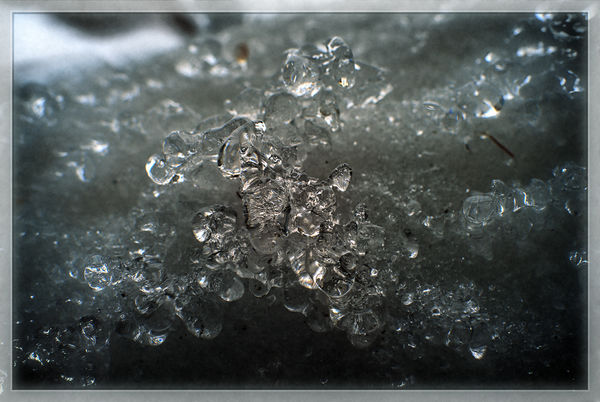Making any lens a macro
Mar 8, 2021 09:24:30 #
warzone wrote:
While I appreciate the input from anyone, I haven’t seen, and perhaps it was my fault, my real question. I was concerned about leaving the contact points which are normally covered when the lens is properly attached. Reversing the lens leaves this points open to dust, debris, etc. Any comments on that point?
All true - so be careful ! Take canned air and blow it out. Keep covered with a plastic bag when stored or not in use.
.
Mar 8, 2021 09:39:44 #
Retina
Loc: Near Charleston,SC
warzone wrote:
I’ve seen articles about making any lens a macro by reversing the lens by using an adapter. I am a little paranoid about leaving the lens connectors open to air, dust, etc. Anyone have any experience on this?
When using tubes or bellows and a reversing adapter ring, I would be less concerned about the connectors than the shutter chamber being exposed to dust when putting things together or taking then apart, especially with a MILC. A fast normal lens extended and reversed can yield surprisingly good results. I do not know much about the physics of lens design other than what was already stated about flatness of field.
Mar 8, 2021 09:47:55 #
For reversing a lens, a short prime lens or short zoom lens is best. Since a reversed lens won't lend you aperture control, you will have a much easier time if you simply use a manual lens and close down the aperture to f/11 or smaller by hand. So don't worry about the electrical contacts. If you really want to use a lens with electrical contacts anyway, you can put an inexpensive non-electrical adapter for that lens on the outward facing contact side. But you will need to learn the trick to stop down the aperture first and let it "hold" there while you reverse the lens.
Lots of info online about the method, but here are pictures that show you what reversed lenses can do: https://www.flickr.com/groups/reverselens/pool/
Lots of info online about the method, but here are pictures that show you what reversed lenses can do: https://www.flickr.com/groups/reverselens/pool/
Mar 8, 2021 09:48:53 #
olemikey wrote:
I would use some sort of protection over the conta... (show quote)
Thank you for addressing my concern.
Mar 8, 2021 09:53:51 #
If the aperture and focus is controlled electronically like all of my lenses, you have to shoot wide open, or set the camera to the desired aperture, maybe hold down dof preview, and remove the lens while the camera is still on to lock in the aperture. Then you are focusing dark though. Extension tubes on good lenses can give good results, and they pass the electronics from the camera to the lens. For a rough idea of magnification divide the extension tube length by the lens focal length. So 25mm extension on a 50mm lens could give about .5x magnification. You get very narrow dof.
Mar 8, 2021 10:16:29 #
warzone wrote:
While I appreciate the input from anyone, I haven’t seen, and perhaps it was my fault, my real question. I was concerned about leaving the contact points which are normally covered when the lens is properly attached. Reversing the lens leaves this points open to dust, debris, etc. Any comments on that point?
I used to do it with lenses that both had 52mm threads on the front of each lens. It was practical for indoor setups as the working distance was very short. I used a metal macro coupler to attach the lenses. If you are worried about the "end lens" getting damaged, some used a plastic lens cap and cut away it base to make sure the end did not touch anything.
Extension tubes with a macro lens is what I use 99.9 % of the time.
Mar 8, 2021 10:16:56 #
bleirer wrote:
If the aperture and focus is controlled electronic... (show quote)
Good points. Using dof preview is how to lock in an aperture on a lens, and then you can detach the lens and it will hold that aperture. At least that's the trick for Canon cameras that I know. Its a bit fussy, really.
The edge to edge image quality of a reversed lens is described as being better than a 'forward' lens on extension tubes, but extension tubes are mighty convenient, and I always crop my pictures anyway. And with electronic extension tubes you can focus and compose wide open, which is a lot easier too.
Here is what an ordinary 50mm can do on extension tubes.
Mar 8, 2021 10:24:52 #
With lenses reversed the magnification is determined by dividing the focal lengths of both lenses. For example, 100mm /50mm = 2x. 200mm/50mm= 4x.
Mar 8, 2021 10:36:01 #
warzone wrote:
While I appreciate the input from anyone, I haven’t seen, and perhaps it was my fault, my real question. I was concerned about leaving the contact points which are normally covered when the lens is properly attached. Reversing the lens leaves this points open to dust, debris, etc. Any comments on that point?
If you mean the contacts on the lens, I’d think twice about covering them with tape. Dust can be easily blown off (if it’s even necessary), but tape will likely leave a sticky residue (not sure about gaffer’s tape) which will then have to be cleaned with a solvent that (one that won’t damage the contact mounting). I’d be more careful/concerned that the mounting ring or adapter doesn’t short or damage the contacts on the body.
Mar 8, 2021 10:58:21 #
Orphoto
Loc: Oregon
photoman43 wrote:
With lenses reversed the magnification is determined by dividing the focal lengths of both lenses. For example, 100mm /50mm = 2x. 200mm/50mm= 4x.
That applies to stacked lenses. A different beast.
Mar 8, 2021 11:28:36 #
fetzler
Loc: North West PA
warzone wrote:
I’ve seen articles about making any lens a macro by reversing the lens by using an adapter. I am a little paranoid about leaving the lens connectors open to air, dust, etc. Anyone have any experience on this?
Indeed there are several ways to get close focus.
1. Reverse a lens. Advantages - its cheap. Disadvantages - you may lose aperture control. Aperture control works with old manual focus lenses. Magnification range is limited.
2. Extension tubes - Automatic tubes provide aperture control. Your lens can be wide open during focusing and close automatically during exposure. Non- macro lenses have barrel and pincushion distortion so they are often not for copy work but are fine 3D objects. To change magnification you may have to dismount the lens and add or subtract extension tubes.
3. Macro lenses - these offer the best optical quality and minimal distortion.
4. Microscope objectives - use for high magnification work. These can be good but require a bit of study and practice.
Of the first three my preferences are 3, 2 and only 1 if absolutely necessary.
Mar 8, 2021 11:34:15 #
fetzler
Loc: North West PA
Mark Sturtevant wrote:
For reversing a lens, a short prime lens or short ... (show quote)
I have seen some adapter that allow manual aperture control on a lens with electrical contacts. It mounts to the normal lens mount. Too big a pain for me, however.
Mar 8, 2021 12:07:05 #
warzone wrote:
I’ve seen articles about making any lens a macro by reversing the lens by using an adapter. I am a little paranoid about leaving the lens connectors open to air, dust, etc. Anyone have any experience on this?
I never tried the reversing ring approach but I have tried extension tubes and many years ago I tried a macro adapter that attached like a filter. The extension tubes come in different sizes and I found them to be more trouble than I wanted to deal with. But a true macro lens need not be expensive. I have a Tamron macro lens but it was big and it required an adapter so I rarely have it handy. I recently bought a 25mm Newer lens that is cheap (about $70), light and small enough to put in my bag for ready use in the fairly rare case that feel I need one. It works to my satisfaction (example below).
Mar 8, 2021 12:08:40 #
warzone wrote:
I’ve seen articles about making any lens a macro by reversing the lens by using an adapter. I am a little paranoid about leaving the lens connectors open to air, dust, etc. Anyone have any experience on this?
Decades ago, shooting with a Nikormat, I had some success using a reversing ring with my 50 mm. Once I could afford to buy a macro lens, I didn't ever go back to the reversing ring.
Mar 8, 2021 12:24:58 #
RWR
Loc: La Mesa, CA
warzone wrote:
While I appreciate the input from anyone, I haven’t seen, and perhaps it was my fault, my real question. I was concerned about leaving the contact points which are normally covered when the lens is properly attached. Reversing the lens leaves this points open to dust, debris, etc. Any comments on that point?
A short extension tube on the reversed lens will protect the mount and rear element, while serving as a lens hood.
If you want to reply, then register here. Registration is free and your account is created instantly, so you can post right away.





